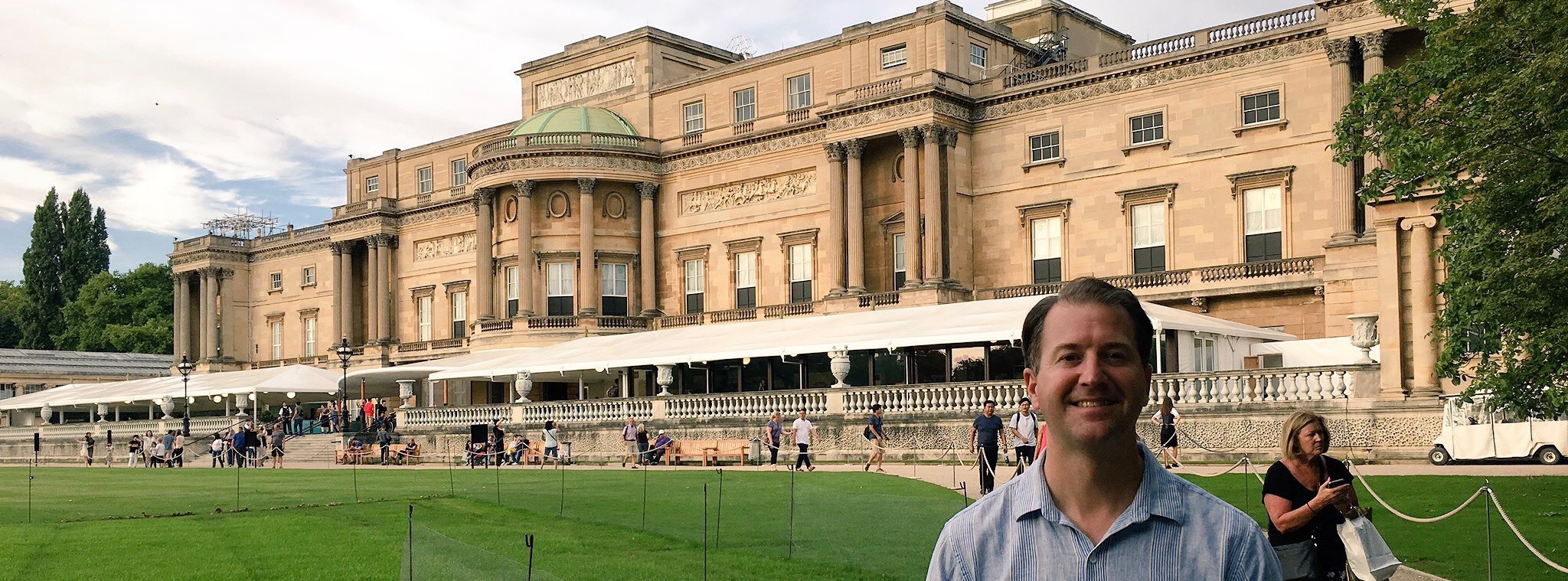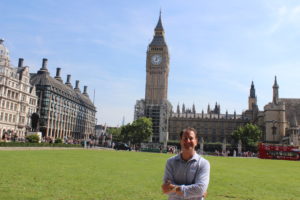
After spending twelve days traveling around Central Europe, I left Prague to head to London. I was expected to be there by Monday night in preparation for a dinner that National Review Institute was doing for some of our supporters and friends in London on Tuesday night. Given this opportunity, I took the first flight out of Prague on Monday in order to have as much of a full day of sightseeing in London as possible.
Previous to this trip, I had only been to London on one occasion – back in the summer of 2000. In fact, it was the first foreign destination I had ever been to. I was only able to spend two days there then – as it was just ahead of my time studying abroad in Spain while in college. While I did the quick London double decker tour bus there one day then, and spent another day at Wimbledon, I really never felt like I got to see as much as I wanted. This time, my goal was to visit Westminster Abbey, the Churchill War Rooms, and the Buckingham Palace. And, on this Monday, I was able to do all that.
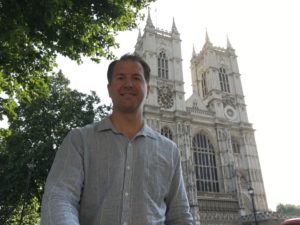
I landed in London shortly before 8am (I gained an hour flying from Prague), took an Uber from the Heathrow airport into the city, and arrived at my hotel, the Royal Trafalgar by Thistle (near Trafalgar Square) by 9:30am. This hotel was great and near everything I wanted to be at. I could walk to all the locations above. I had made reservations for all three of these historic sights a month in advance. I was also there on a “bank holiday” so I think that also made the general area I was in less busy than usual.
I was really overwhelmed by Westminster Abbey and Buckingham Palace. Both were so ornate with much history and grandeur. Until I visited, I wasn’t really aware that in addition to all the monarchs being crowned at Westminster Abbey, many important people in history are buried there too, many inside. I walked by gravestones of authors like Charles Dickens, scientists like Sir Isaac Newton, and kings, queens, and other royalty from across the centuries. The church was also simply amazing both inside and out, but the inside was just spectacular. Words don’t do it justice. I’m sure photos don’t either (and they don’t allow photography inside it).

I really feel that of all the places in England, Westminster Abbey really encompasses the English heritage more than any other place. And the fact that it is still a place of worship, I was almost reminded of the philosophy of Edmund Burke who stated that the living, the dead, and those yet to be born are all connected. For the English, I think this is the place where that thought really comes to fruition more than any other place anywhere.
After finishing the 90-minute or so tour of Westminster Abbey (they have an excellent audio guide that comes with the tour), I walked outside and just across the way was “Big Ben” – the famous clock tower that encompasses part of the Parliament building. It was partly under construction with scaffolding covering most of the bottom half, but it was still impressive to see again. I then walked over to a pub and had lunch, before walking over to the Churchill War Rooms.

Over the previous nearly two weeks I had traveled throughout Central Europe and saw the Dachau concentration camp, Hitler’s Eagle’s Nest, and the many places in Austria, Hungary, Slovakia, and the Czech Republic which were all affected by the horrors of World War II. Today, I was walking through an underground bunker where the Prime Minister of England, Winston Churchill, spent many of his days and nights, along with many others in the British high command, conducting and overseeing the operations of the war.
I have always admired Churchill and the more I learn about him, his philosophy, and his leadership, the more I admire him. However, there was nothing like seeing Churchill’s war rooms to make me appreciate the man even more – and to make me appreciate the true threat to London, to England, and to all of Western Civilization; to see the courage it must have taken to not abandon London, just blocks from where the Nazis were bombing the city. I walked through rooms from which Churchill recorded some of his famous radio addresses to the British people. I saw strategic military maps on the wall and the bunks where he took his afternoon naps. I learned how those naps allowed him to stay up through many hours of the night, and how the man just worked relentlessly.

Within the war rooms is also included a museum of Churchill’s life. You realize when walking through some of his early life, as well as his early political career, that there was no inevitability for him to rise to the level of Prime Minister – or to keep it after he led his nation and much of Western Civilization, towards victory in Europe. I also learned that he smoked, on average, eight cigars per day (not to mention some glasses of liquor to go along with it). The man lived to be 90. But more importantly, he lived to see his nation survive. I hope we in the West understand the sacrifices the British people and leaders like Churchill went through during that time, and continue to keep their spirit alive.

Later that afternoon, I walked over to Buckingham Palace for my 5:00 PM tour. It took me a little more than an hour to go through it, also accompanied by an excellent audio guide that is included with the tour. What an amazing place! It looks beautiful from outside, but inside was just a whole ‘nother ball game. I had gone through several palaces and castles during this trip, but I think the one thing that stuck out to me most about Buckingham Palace was the fact that it is still in use today, and very much so. There’s only a few months a year where one can tour it, while the Queen is away for the summer and I was privileged to be there during this time of the year. The artwork and the grandeur within it was quite amazing. On this tour, they also had many gifts from other countries to the Queen that were on display. And the gardens outside were very tranquil as well.
To someone like me, from America, it seems strange to still have a monarch, especially in a country in the West, in the 21st century. But in some ways, I guess that’s just how they divide the duties. The Queen seems to wear the title of the “head of state,” which is just one of the many hats our President wears today.
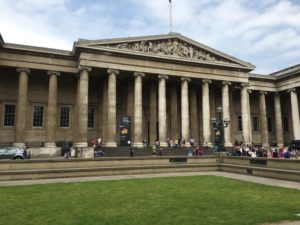
After visiting the palace, I intended to find a pub recommended to me by my friend Andrew Bulovsky who spent a couple years here at the London School of Economics. However, that particular pub was closed – many were – due to the bank holiday. Funny enough, I found another pub he recommended that was open, but due to the bank holiday, they were only serving drinks. Go figure, with the British. Well I had a pint there and then found another nearby pub that was serving food. It was near the London School of Economics, so I walked through that area too. After dinner, I walked back to my hotel. I passed through Picadilly Circus and back into Trafalagar Square to retire for the night.
The next morning, I was officially “back to work.” I met my boss and her family for breakfast in the hotel and then proceeded to catch up over many emails and make preparations for that evening and the coming days where I would be hopping on the National Review cruise. But, I did manage to get in a nice three-hour lunch break in the afternoon and spent two of those hours at the British Museum, which was about a 15-minute walk from my hotel. I really enjoyed walking through the streets of London, which seemed a bit more hopping on this Tuesday after the Monday bank holiday.
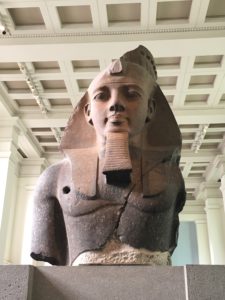
The British Museum was sort of a “bonus” for me, because I didn’t think I’d find time to do it and I’ve always wanted to. They have collections from all around the world. Many of these collections were “taken” during the heyday of the British Empire, when they occupied many foreign lands. Some of my favorite collections were from Egypt. They had statues of pharaohs, tombs of mummies, and artifacts like the Rosetta Stone. I also enjoyed seeing artifacts and artwork from the Middle East, from Greece and Rome, as well as from other times and places in Europe, Asia, and the Americas.
In two hours, I managed to walk through every room in the museum, stopping at specific places for longer periods than others. I imagine you could spend many visits here really analyzing everything in detail. Two other rooms that caught my attention featured currency from different times and places in history, as well as clocks and other timekeeping devices. Another bonus of this museum: it is free (of course, they ask for donations too). I imagine that might allow someone locally to come back for many visits to view things in more detail.
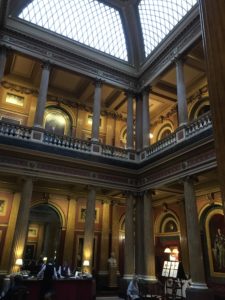
After finishing the museum, I walked back to my hotel, finished my last bit of work, and then met my boss Lindsay to prepare for our dinner that evening at the Reform Club of London. One of our NRI Fellows, John O’Sullivan, who now resides in Budapest, is from England and is a member of the Reform Club. This allowed us to host our group there, in a private room at this private club, and we were joined by John as well as NRI Fellow David French, plus two other local scholars. We had a group of about 16 of us and discussed public policies related to national security, free speech, and the changing culture in both the U.S. and the U.K.
The next morning, I woke up and went for a three-mile run around St. James Park, which surround Buckingham Palace. While it had been sunny and warmer in London (in the 70s and 80s) on Monday and Tuesday, it had significantly cooled down overnight. When I ran at 8:30am, it was about 57 degrees and cloudy. It felt great. Being from Central Florida, we won’t see those temperatures for at least another month or two (and probably only briefly) and we definitely never see anything close to that cool this time of year.
A little bit later, David, Lindsay and her family, and I all went to the Waterloo train station and took a 1pm train down to Southampton, England. It was about a 90-minute or so ride. Southampton is where the National Review cruise would take off the next day on the Queen Mary 2. We would be doing seven nights at sea on a transatlantic voyage that eventually takes us to New York. My last days and hours in Europe were coming to a close on this trip. I think it was fitting that it ended here in the United Kingdom, a nation that still has such close ties with the United States, but also a place where Western Civilization took a courageous stand just over 70 years ago. And now, we continue to head west…
